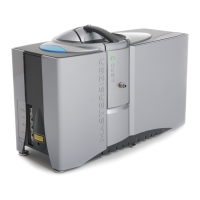Hardware features
14
1. Tank light
2. Over-flow (castellations)
3. Breather holes
4. Baffles
Over-flow system and drain
An over-flow is located underneath the metal shield on the top of the sample tank; this is
indicated by castellations at the bottom edge of the shield.
If too much fluid is filled into the tank, any excess will overflow into here and sub-
sequently out of the drain pipe at the rear of the unit. Overfilled tanks may lead to
particles being lost via the over-flow system. This will lead to an incorrect particle size dis-
tribution being reported.
Caution!
If the tank is manually filled, make sure it is done slowly so the tank does not
overflow. Never overfill the tank as spillage may occur once the pump starts.
Clean any spillage off the covers immediately to prevent damage.
Breather hole
A breather hole is incorporated into the metal shield on the top of the sample tank. This
is used to enable a sufficient draining rate when the tank is emptied.
Note: If the tank is underfilled, air may be entrained into the liquid. This will
lead to an incorrect particle size being reported.
Baffles
The tank incorporates baffles; these interrupt the sample flow and help mix the sample
and dispersant.

